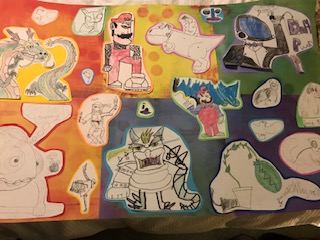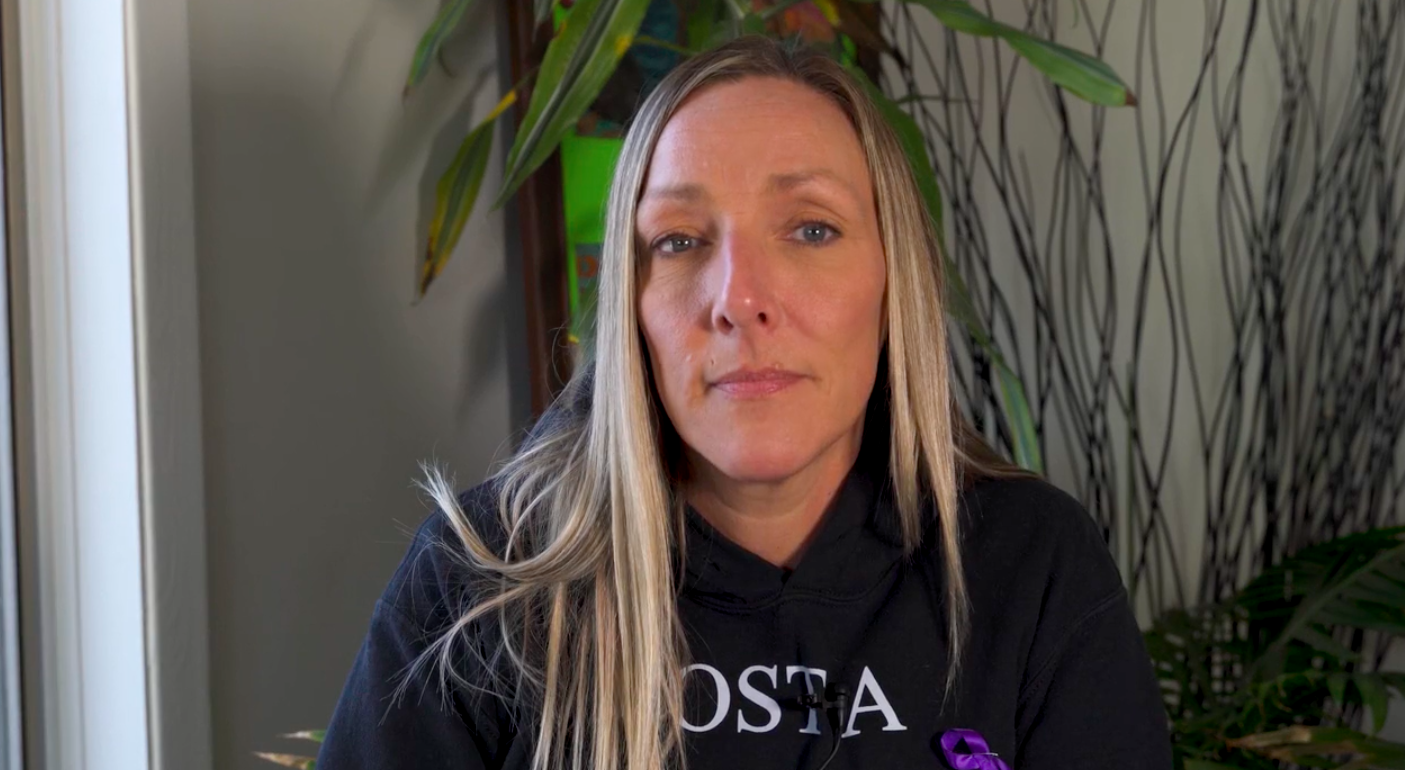Posts Tagged ‘art therapy’
Doodles
By Betsy Fisher
Surviving.
Wading into all the “firsts” I never wanted to see.
On the first anniversary, I invited people who would understand – friends who knew Marshal’s love of art, and his creative spirit. They all came.
I had copied several of Marshal’s doodles of incomplete characters and creatures, with some finished for the kids to color. I eagerly watched to see which doodle or drawing each person chose.
“Hey! That looks like Abraham Lincoln! I want to finish that one.”
“Cool…look at this giraffe! I want to color this one!”
“Whoa, what a cool monster!”
“What is this one?! I think it’s some kind of frog.”
The children sat in the kitchen table or on the porch, clutching crayons with great care and the grownups chose doodles and pieces of something larger, saying, “Oh, yes, Marshal would have loved this.”
People smiled as they drew or colored. I found myself smiling, too, even laughing now and then. I walked among them and as I watched them, I felt things I had not felt before, things I could not name.
I had stressed over “what to do” to mark this date, one year later, where ending and beginning would meet. Marshal took ordinary, simple things, and created magic.
Among the many doodles was one of a man-eating plant. A Venus Flytrap like the one from “Little Shop of Horrors” but with a face and personality of its own. It is stretching over and about to swallow up a stick figure. “Oh snap!” says the figure. “Why me?!”
An 8-year-old boy chose that drawing to color. The little hero had miraculously survived cancer as a toddler, and now he was a full-on, healthy, nothing-but-smiling little boy. We met him, and his mother, at Shands, and we grew to know and love them well in the years to follow.
He remembers Marshal a little – his famous fart sounds, character voices, and artistic creations. Their shared love of Mario. He carries his lunch to school today in Marshal’s Mario backpack. He was so excited to get started.
His picture was so colorful and he showed it to me with such pride. I told him more than once just how much Marshal would have liked what he had done with it.
They all seemed to know how important it was to me. They seemed to know Marshal would be there, too. And he was.
As I took it all in, Marshal seemed so strangely present. I felt a different “alive” than I had felt in that first terrible year of grief. He was my smile, the lump in my throat with every hello and goodbye. He was the twinkle in my eye as I saw their love, as I immersed myself in this afternoon.
I hadn’t been sure I could handle the laughter, or making this saddest of days a happy one, somehow. But I could, and it was.
Many of them left their doodles for me to keep or sent pictures after finishing them at home. A friend took them all and made a simple collage, now in my room.
It is love carrying on. It is my proof. Living proof that just as more can be made from these incredible beginnings of doodles and sketches, more can be made from my story with Marshal. Maybe I can move forward, bringing him along with me.
Legacy. Life. Continuity. Connection.
Always and every day.
If you’d like to draw and color with Marshal’s doodles, email Betsy at marshalsdoodles@gmail.com.
Nicole – Using Art and Creativity to Express Grief
Nicole – Using Art and Creativity to Express Grief
Nicole discusses the work she does to allow access to creative outlets such as art hives and gardening.
The Reflection Room® project: How storytelling supports processing grief
The Saint Elizabeth Foundation offers a project called the Reflection Room – a space for thinking and talking about dying, death, and grief.
The Reflection Room project is an evidence-based participatory art installation that was developed by researchers at the SE Research Centre and Memorial University in 2016. The project included a research component that evaluated the impact of Reflection Rooms as the project adapted over time to address changing needs.
The Reflection Room project was first developed to support people in community and healthcare settings to move from death-denying to death-discussing. From the first installation, the Reflection Room project has gone through three Phases of adaptation and continues to evolve.
Common elements across Reflection Rooms, whether they are set up to include an entire room, hallway, or corner of a room, include a quiet, calming space that invites visitors to read other people’s stories and post their own. The rooms are unstructured and unfacilitated, allowing visitors to engage with the space however they wish.
Over a five-year period from 2016-2020, the Reflection Room project was installed in 62 places across Canada, including in conferences, art galleries, hospices, and hospitals (Phases 1 and 2). Over a thousand stories were shared by individuals during their visits to these various Reflection Rooms. Results from the study from this period showed that storytelling can be an important part of grieving.
In 2020, Phase 3 of its adaptation and evaluation began with the SE Research Centre being asked to expand the reach of the Reflection Room to long-term care home communities in Ontario to respond to some of the accumulated pandemic-related grief in those communities. With the support of the Saint Elizabeth Foundation, Ontario Health Central, Family Councils Ontario, Ontario Centres for Learning, Research and Innovation in Long-Term Care, and Ontario Association of Residents’ Councils, over 50 homes signed up to host a Reflection Room®. In order to adapt to the environment of long-term care homes, an easy-to-set-up ‘kit’ incorporating instructions and materials (e.g., Reflection Cards, a red curtain to display Reflection Cards, candles, etc.) was developed and sent to homes free of cost. Overwhelmingly positive feedback has demonstrated that the Rooms support communities to work through grief by having a quiet space to rest and reflect, disclose emotions, process thoughts, and feel connected to others through sharing stories. The project often is complementary to other existing initiatives in long-term care homes such as palliative care committees and spiritual programs.
A collection of the stories shared over the course of the project is available to view on the Reflection Room website.
If you want to learn more about the project, contact foundation@sehc.com and listen to the Grief Stories podcast episode 64.
Neeliya Paripooranam, MSc, is a Project and Communications Manager at the SE Research Centre, overseeing the Reflection Room® project. Celina Carter, RN PhD, is a Senior Research Associate at the SE Research Centre. Paul Holyoke, PhD, is the Vice President, Research and Innovation at SE Health. Justine Giosa, PhD, is the Scientific Director, SE Research Centre and Adjunct Assistant Professor in the School of Public Health Sciences at the University of Waterloo. Hana Irving, MA, is the Director, Philanthropic Programs for the Saint Elizabeth Foundation.
There One Day and Gone the Next : Art Therapy and Grief
By Sarah Smith DTATI, BFA
Over the last 12 years or so, I’ve had the opportunity to work with those grieving individually and in group settings, which has provided me with experience and insight into how art therapy (and art as therapy) can be beneficial to those dealing with loss.
What is Art Therapy?
“Art therapy combines the creative process and psychotherapy, facilitating self-exploration and understanding. Using imagery, colour and shape as part of this creative therapeutic process, thoughts and feelings can be expressed that would otherwise be difficult to articulate,”(CATA, 2022).
There’s no right or wrong in art therapy, it’s a matter of using the art as a vessel for wellness along side a trained professional. There are many benefits one can receive from engaging in the art making process such as: healthy coping strategies, insight, emotional stability/balance, stress /anxiety reduction, grounding of emotions, pleasure/joy, creativity, safe space, expression, control, freedom, and connection among many others!
Art Therapy and Grief
Grief is a very layered and challenging thing that is unique for each individual who experiences loss.
Because there is no “proper” way to grieve, art therapy can make for an excellent coping strategy as it allows for each person to express themselves in the way that’s best for them.
Unlike traditional “talk therapy”, art therapy has the art, so this means that one does not need to speak if they don’t want to or if they cant find the way to articulate how they feel into words. Sometimes, while people are grieving they cant even pin point how they feel and at other times the emotions can just be so overwhelming it can affect one physically and to try and talk about the emotions just exacerbates them.
Creating art in itself can be a healing thing. It can be a fun or relaxing thing to do. Engaging in an art therapy session can allow for so many more benefits. The art therapist can provide the participant with specific art therapy directives and art materials that they feel may be beneficial to your needs. Art therapists are trained to read and assess clients’ artwork. This means they may see things you may have missed that you might benefit from if brought to your attention. This insight makes it a great learning tool for self-discovery. We as art therapists believe that the art work holds the subconscious. What’s great about this for those who are grieving is that people can process however they need to. Some people need more time to process, some people need a more gentle approach where they feel in control, some people refuse to acknowledge things, and some people are just going through the motions and engaging in the art making process. The subconscious is purging and the healing is happening whether they realize it or not.
Art Therapy Directives (examples)
I facilitated a workshop at a hospice a couple years ago and offered it to those who had lost a loved one. The workshop began with a few art therapy warm-up exercises with the intention of helping everyone feel a bit more comfortable in the space and with each other.
The first art therapy directive I had them do was make flowers out of coffee filters, markers, and water. I wanted them to make something symbolic for their loved one. They began by writing whatever they wanted onto the coffee filters. Some people wrote the persons name, poems, a memory, or even drew a picture. They then watered down the filters and the colours began to bleed. Some people cried during this part. They could resonate with the symbolism. The water like tears. The bleeding of the colours representing pain, fuzzy memories, and a distant grasp on the person. When the coffee filters had dried we had turned them into flowers. The transformation of taking what we lost and carrying it forward in a new way was very powerful to witness and a very healing thing to say the least.
The second art therapy directive was focused more on the individual rather than the deceased. I gave everyone a mask. I instructed them to paint the front of the mask how they appear to the world and I asked them to create on the inside of the mask to show how they really feel or how they are actually doing (see figure 1).
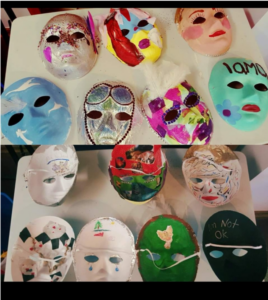
Figure 1.
They shared their art work from the workshop, but it was heavy. They were feeling sensitive and tired among other feelings so I had them sit and talk for a bit and then had them pull a self-care card for a distraction before letting them and drive home, as it may not have otherwise been safe for anyone overwhelmed after such an engaging session. This is typically how I run a grief workshop. Before they left the hospice asked them to fill out a score sheet to see how they felt about participating in the workshop and everyone said they liked it and for reasons, such as that they felt less anxious, they felt less alone, the felt lighter and more hopeful after the workshop.
At another hospice art therapy workshop, I had them create memory boxes. I provided them with a wooden box along with a variety of art materials, the only thing I asked was that they brought in a picture of the person they had lost. The purpose of this was to give them an opportunity to create something that could hold two energies, a place to honour them deceased, but also something tangible for them to have and hold. From my observations, I remember them taking a lot of time on these boxes and they were very quiet while making them. When they shared them, they were emotional, of course, but pride came through, it was like they made them for their people and wanted to make them well, so that their loved one would really like the box. This made them feel good for reasons such as honouring the person still while they are gone. Some people felt that their guilt had been eased a bit because they were physically doing something for that person who was no longer here. To see an example, see figure 2 and 2b.
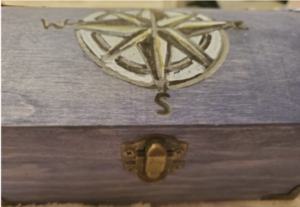
Figure 2
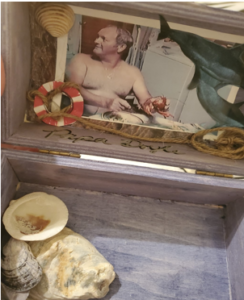
Figure 2b.
Following the memory boxes, I had them paint a step by step painting for their loved one. This was more of an art as therapy approach. This means they were literally using the art itself for wellness. They followed along with me and painted a whole painting. By following me, they were able to safely let go and get lost in the art making process. The intention was to enjoy the process while also giving them a healthy mental and emotional escape for however long it took us to paint the picture. I selected a picture of trees that had no leaves, purposely to symbolize letting go, loss, and reflection but the painting had an element of hope to it, the tress were pointing up to the sky, facing the light and there was lots of colour (see figure 3).
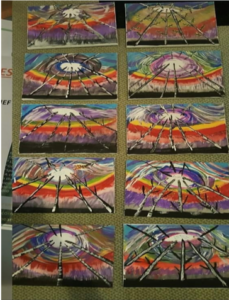
Figure 3.
The photos below are some examples of art from some of my sessions with clients around grief. They speak for themselves.
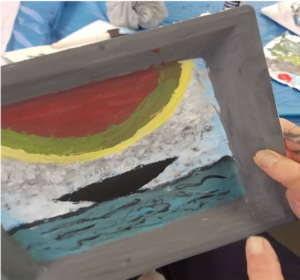
Figure 4.
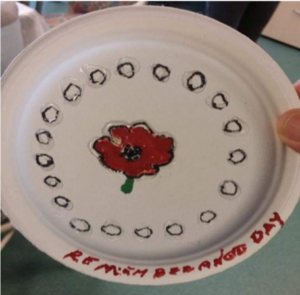
Figure 5.
Jacqueline – My Story
Jacqueline – My Story
Jacqueline talks about getting through the feelings after her mother’s death
Jacqueline – Art Therapy & Grief
Jacqueline – Art Therapy & Grief
Jacqueline discusses about art therapy and how it brings a special layer to help move through grief
Jacqueline – Where to store art works
Jacqueline – Where to store art works
Jacqueline explains how art can be like journal entries that you would keep private
Jacqueline – Crying
Jacqueline – Crying
Jacqueline talks about how grief is love and how crying is natural
Jacqueline – Digital Story
Jacqueline – Digital Story
Jacqueline discusses what a digital story can be and how creatiing one can create positive breakthroughs
Jacqueline – It’s an Honour
Jacqueline – It’s an Honour
Jacqueline explains why it’s an honour to be a part of her clients healing journey
Jacqueline – Humour
Jacqueline – Humour
Jacqueline talks about how huour has a place in grieving
Jacqueline – Art therapy and grieving women
Jacqueline – Art therapy and grieving women
Jacqueline explains how helping connect to the heart and reslience with art therapy can be very helpful

